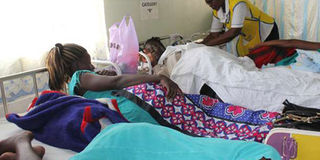Non-emergency cases crowd major hospitals - doctors

A senior nurse attends to a pregnant mother in a hospital on July 19, 2015. MTRH has received 3,883 patients between June and August who were admitted with a maternal mortality rate of 1.7 per 1,000 deliveries. PHOTO | VERAH OKEYO | NATION MEDIA GROUP
What you need to know:
- But, the Moi Teaching and Referral Hospital (MTRH) and Kenyatta National Hospital (KNH) will have to attend to them as a “priority” as stipulated by guidelines.
- However, some of the patients are referred “too late” and the expectant mothers die en route or while in hospital.
Some of the pregnancy-related complications marked “emergency” by county hospitals and taken to referral facilities are unnecessary, the Nation has learned.
That is, they are not conditions that threaten life, limb, or eye sight as defined by the 2014 Kenya Health Sector Referral Implementation Guidelines.
But, the Moi Teaching and Referral Hospital (MTRH) and Kenyatta National Hospital (KNH) will have to attend to them as a “priority” as stipulated by guidelines.
In an analysis of data in the past three months from the two referral facilities, some cases would have been treated in the lower county facilities instead of being rushed to the already crammed national facilities.
For instance, MTRH has received 3,883 patients between June and August who were admitted with a maternal mortality rate of 1.7 per 1,000 deliveries.
Interestingly, most maternal health related referrals to KNH are from Machakos, Nairobi, Kiambu and Thika, according to Dr John Ong’ech, head of reproductive unit at the facility.
MTRH on the other hand covers an even larger scope: Uasin Gishu, Nandi, Baringo, Trans Nzoia, West Pokot, Turkana and Elgeyo-Markwet, but some patients are even referred there from as far as Kisumu, Busia, and Eastern Uganda.
Most of the cases, which come from neighbouring counties are due to “assumed diagnosis which might be wrong” or in some cases, misdiagnosis, said Head of the Division of Reproductive Health at MTRH, Dr Philip Kirwa.
“When they get here, we find out that some of these referrals were unnecessary and then there are patients who are referred for simple procedures such as ultra sound or even blood transfusion,” he said.
He said in some cases, referrals swell during the weekend because there are no doctors in the county facilities.
It is a similar case in Nairobi as numerous ambulances on Friday’s dash in different parts of the town, headed to KNH to bring in patients referred from the neighbouring counties.
ALTERNATIVE
Dr Kirwa added: “Sometimes, a specialist could be on leave and has not been replaced and patients are put in ambulances and sent to us. Counties need to invest in not only equipment but also train specialists.”
Sometimes, expectant women or their families refer themselves to these referral facilities because they trust these “specialised facilities than their regional centres”.
In MTRH, on the other hand, mothers are referred because of hypertension, respiratory infections such as tuberculosis and pneumonia; cardiac diseases; severe malaria from Kisumu and Western regions; Kala zar (highly fatal parasitic infection) from Pokot, seeking Intensive Care services; and dialysis - especially for mothers who had severe bleeding with some requiring specialists such as nephrologists.
Most of the complications at KNH are high blood pressure, respiratory difficulties, convulsions, and severe bleeding (before and after deliveries).
However, some of the patients are referred “too late” and the expectant mothers die en route or while in hospital.
According to data from MTRH, most of the maternal deaths — 90 to 95 per cent — were referrals and had conditions where interventions may not make an impact.
Both Dr Ong’ech and Dr Kirwa believe the referral burden in their facilities can be eased if county facilities are better equipped and staffed to handle cases.
Dr Kirwa recommends that counties appreciate counter-referrals. That is, a process used to redirect a referred client back to the originating unit for follow-up.
“Once patients are diagnosed and medication is prescribed, they can be referred back to lower levels for follow-up and treatment and free up space for others.”





